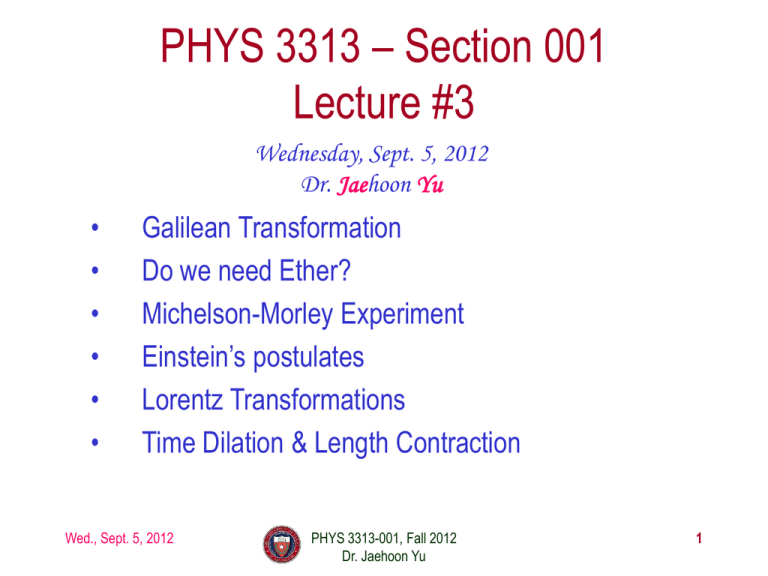Wednesday, Sept. 5, 2012
advertisement

PHYS 3313 – Section 001 Lecture #3 Wednesday, Sept. 5, 2012 Dr. Jaehoon Yu • • • • • • Galilean Transformation Do we need Ether? Michelson-Morley Experiment Einstein’s postulates Lorentz Transformations Time Dilation & Length Contraction Wed., Sept. 5, 2012 PHYS 3313-001, Fall 2012 Dr. Jaehoon Yu 1 Announcements • Reading assignment: CH 2.3 and 2.4 • Today’s homework problems are (chapter 2 end of the chapter problems): – 17, 21, 23, 24, 32, 59, 61, 66, 68, 81 and 96 – Due is by the beginning of the class, next Wednesday, Sept. 12 – Work in study groups together with other students but PLEASE do write your answer in your own way! Wed., Sept. 5, 2012 PHYS 3313-001, Fall 2012 Dr. Jaehoon Yu 2 Special Project #1 1. 2. 3. • • • Compute the electric force between the two protons separate the farthest in a U238 nucleus. Use the actual size of the U238 nucleus. (10 points) Compute the gravitational force between the two protons separate the farthest in a U238 nucleus. (10 points) Express the electric force in terms of the gravitational force. (5 points) You must look up the mass of the proton, actual size of the U238 nucleus, etc, and clearly written on your project. You MUST have your own, independent answers to the above three questions even if you worked together with others. All those who share the answers will get 0 credit if copied. Due for the submission is Monday, Sept. 10! Wed., Sept. 5, 2012 PHYS 3313-001, Fall 2012 Dr. Jaehoon Yu 3 Research Projects 1. Each of the 10 research groups picks one research topic 2. Study the topic as a group, looking up references – – – Original theory or Original observation Experimental proofs or Theoretical prediction + subsequent experimental proofs Importance and the impact of the theory/experiment 3. Each member of the group writes a 10 page report, including figures (must not copy!!) – – – 10% of the total grade Can share the theme and facts but you must write your own! Due Mon., Nov. 26, 2012 4. The group presents a 10min power point talk – – 5% of the total grade Date and time will be announced close to the end of the semester Wed., Sept. 5, 2012 PHYS 3313-001, Fall 2012 Dr. Jaehoon Yu 4 Research Topics 1. Black body radiation 2. Michelson–Morley experiment 3. The Photoelectric effect 4. Special Relativity 5. The property of molecules, Browning Motion 6. Compton Effect 7. Radioactive 8. Rutherford Scattering 9. Super-conductivity 10. The Unification of Electromagnetic and Weak forces Wed., Sept. 5, 2012 PHYS 3313-001, Fall 2012 Dr. Jaehoon Yu 5 Group – Research Topic Association Research Group Number Research Topic 1 6 2 3 4 5 5 7 2 1 6 7 8 9 10 4 9 3 10 8 Wed., Sept. 5, 2012 PHYS 3313-001, Fall 2012 Dr. Jaehoon Yu 6 Newtonian (Classical) Relativity • It is assumed that Newton’s laws of motion must be measured with respect to (relative to) some reference frame. • A reference frame is called an inertial frame if Newton laws are valid in that frame. • Such a frame is established when a body, not subjected to net external forces, is observed to move in rectilinear motion at constant velocity • Newtonian Principle of Relativity (Galilean Invariance): If Newton’s laws are valid in one reference frame, then they are also valid in another reference frame moving at a uniform velocity relative to the first system. Wed., Sept. 5, 2012 PHYS 3313-001, Fall 2012 Dr. Jaehoon Yu 7 Inertial Frames K and K’ r • K is at rest and K’ is moving with velocity v • Axes are parallel • K and K’ are said to be INERTIAL COORDINATE SYSTEMS Wed., Sept. 5, 2012 PHYS 3313-001, Fall 2012 Dr. Jaehoon Yu 8 The Galilean Transformation For a point P In system K: P = (x, y, z, t) In system K’: P = (x’, y’, z’, t’) vt P x K K’ x’-axis x-axis Wed., Sept. 5, 2012 PHYS 3313-001, Fall 2012 Dr. Jaehoon Yu 9 Conditions of the Galilean Transformation • Parallel axes between the two inertial reference frames • K’ has a constant relative velocity in the x-direction with respect to K • Time (t) for all observers is a Fundamental invariant, i.e., the same for all inertial observers – Space and time are separate!! Wed., Sept. 5, 2012 PHYS 3313-001, Fall 2012 Dr. Jaehoon Yu 10 The Inverse Relations Step 1. Replace with Step 2. Replace “primed” quantities with “unprimed” and “unprimed” with “primed” Wed., Sept. 5, 2012 PHYS 3313-001, Fall 2012 Dr. Jaehoon Yu 11 The Transition to Modern Relativity • Although Newton’s laws of motion had the same form under the Galilean transformation, Maxwell’s equations did not. • In 1905, Albert Einstein proposed a fundamental connection between space and time and that Newton’s laws are only an approximation. Wed., Sept. 5, 2012 PHYS 3313-001, Fall 2012 Dr. Jaehoon Yu 12 They Needed Ether!! • The wave nature of light suggested that there existed a propagation medium called the luminiferous ether or just ether. • The properties of ether – Very low density for planets to move through it without loss of energy – Sufficiently high elasticity to support the high velocity of light waves (c=?) Wed., Sept. 5, 2012 PHYS 3313-001, Fall 2012 Dr. Jaehoon Yu 13 Ether as the Absolute Reference System • In Maxwell’s theory, the speed of light is given by – The velocity of light between moving systems must be a constant. – Needed a system of medium that keeps this constant! • Ether proposed as the absolute reference system in which the speed of light is constant and from which other measurements could be made. • The Michelson-Morley experiment was an attempt to show the existence of ether. Wed., Sept. 5, 2012 PHYS 3313-001, Fall 2012 Dr. Jaehoon Yu 14 The Michelson-Morley Experiment • Albert Michelson (1852–1931) built an extremely precise device called an interferometer to measure the phase difference between two light waves traveling in orthogonal directions. Wed., Sept. 5, 2012 PHYS 3313-001, Fall 2012 Dr. Jaehoon Yu 15 How does Michelson Interferometer work? 1. AC is parallel to the motion of the Earth inducing an “ether wind” 2. Light from source S is split by mirror A and travels to mirrors C and D in mutually perpendicular directions 3. After reflection the beams recombine at A slightly out of phase due to the “ether wind” as viewed by telescope E. Wed., Sept. 5, 2012 PHYS 3313-001, Fall 2012 Dr. Jaehoon Yu Ether 16 The analysis – Galilean X-formation • Travel time t1 for round trip over AC (the ether direction) is l1 l1 2l1c 2l1 1 2 t1 2 cv cv c v c 1 v2 c2 • Travel time t2 for round trip over AD (perpendicular direction to ether) is t2 2l2 2l2 1 2 2 c 1 v2 c2 c v • The time difference is 2 l2 l1 t t 2 t1 2 2 2 2 c 1 v c 1 v c Wed., Sept. 5, 2012 PHYS 3313-001, Fall 2012 Dr. Jaehoon Yu 17 The analysis • After rotating the machine by 90o, the time difference becomes 2 l l t ' t t 2 2 2 c 1 v c 1 v c ' 2 ' 1 2 2 1 • The difference of the time differences 2 l1 l2 l1 l2 2 1 1 t ' t l1 l2 2 2 2 2 2 2 2 2 c 1 v c 1 v c c 1 v c 1 v c • Since v (the Earth’s speed) is 10-4 of c, we can do binomial expansion of the above 2 v2 v2 t ' t l1 l2 1 2 L 1 2 L c c 2c Wed., Sept. 5, 2012 PHYS 3313-001, Fall 2012 Dr. Jaehoon Yu v2 c 3 l1 l2 18 The Results • Using the Earth’s orbital speed as: V = 3 × 104 m/s together with ℓ1 ≈ ℓ2 = 1.2 m So that the time difference becomes Δt’ − Δt ≈ v2(ℓ1 + ℓ2)/c3 = 8 × 10−17 s • Although a very small number, it was within the experimental range of measurement for light waves. • Later with Morley, they increased the path lengths to 11m and improved precision better than a factor of 10 • Yet, Michelson FAILED to “see” the expected interference pattern Wed., Sept. 5, 2012 PHYS 3313-001, Fall 2012 Dr. Jaehoon Yu 19 Conclusions of Michelson Experiment • Michelson noted that he should be able to detect a phase shift of light due to the time difference between path lengths but found none. • He thus concluded that the hypothesis of the stationary ether must be incorrect. • After several repeats and refinements with assistance from Edward Morley (1893-1923), again a null result. • Thus, ether does not seem to exist! • Many explanations ensued afterward but none worked out! • This experiment shattered the popular belief of light being waves Wed., Sept. 5, 2012 PHYS 3313-001, Fall 2012 Dr. Jaehoon Yu 20 The Lorentz-FitzGerald Contraction • Another hypothesis proposed independently by both H. A. Lorentz and G. F. FitzGerald suggested that the length ℓ1, in the direction of the motion was contracted by a factor of • Thus making the path lengths equal to account for the zero phase shift. – This, however, was an ad hoc assumption that could not be experimentally tested. Wed., Sept. 5, 2012 PHYS 3313-001, Fall 2012 Dr. Jaehoon Yu 21 Einstein’s Postulates • Fundamental assumption: Maxwell’s equations must be valid in all inertial frames • The principle of relativity: The laws of physics are the same in all inertial systems. There is no way to detect absolute motion, and no preferred inertial system exists – – • Published a paper in 1905 at the age 26 Believed to be fundamental The constancy of the speed of light: Observers in all inertial systems measure the same value for the speed of light in a vacuum. Wed., Sept. 5, 2012 PHYS 3313-001, Fall 2012 Dr. Jaehoon Yu 22 The Lorentz Transformations General linear transformation relationship between P=(x, y, z, t) in frame S and P’=(x’,y’,z’,t’) in frame S’ these assume measurements are made in S frame and transferred to S’ frame • preserve the constancy of the speed of light between inertial observers • account for the problem of simultaneity between these observers • With the definitions v c and 1 x ' x ct Wed., Sept. 5, 2012 1 y' y z ' z t ' 1 x c PHYS 3313-001, Fall 2012 Dr. Jaehoon Yu 2 23 Properties of the Relativistic Factor γ What is the property of the relativistic factor, ? Is it bigger or smaller than 1? Recall Einstein’s postulate, β = v/c < 1 for all observers • = 1 only when v = 0 1 1 1 2 Wed., Sept. 5, 2012 PHYS 3313-001, Fall 2012 Dr. Jaehoon Yu 24 The complete Lorentz Transformations • Some things to note – What happens when β~0? • The Lorentz x-formation becomes Galilean x-formation – Space-time are not separated – For non-imaginary x-formations, the frame speed cannot exceed c! Wed., Sept. 5, 2012 PHYS 3313-001, Fall 2012 Dr. Jaehoon Yu 25

